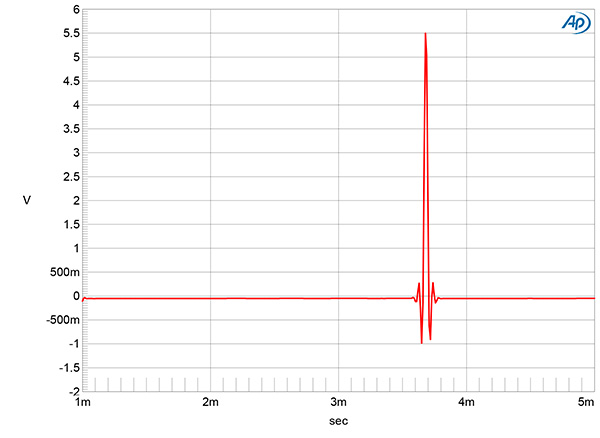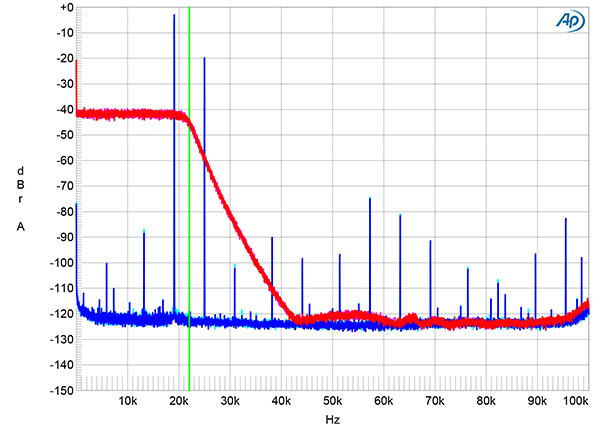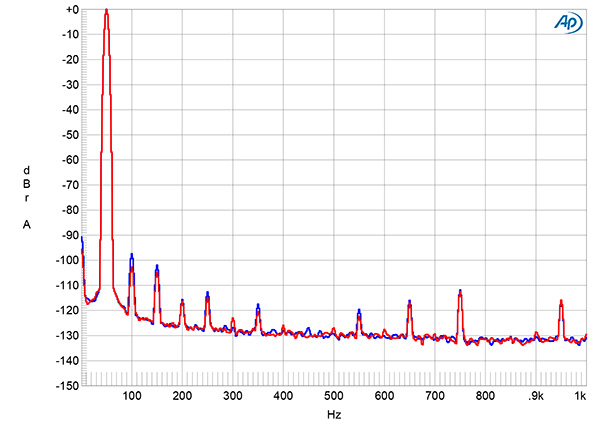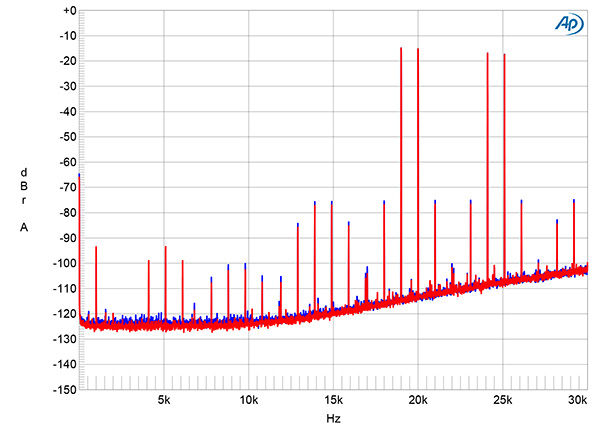| Columns Retired Columns & Blogs |
Great review of what seems to be a great product!
Makes me want to shop!
I measured the iFi NEO Stream using my Audio Precision SYS2722 system. Out of the box, the review sample was running firmware version 2.15.8. When I connected the iFi to my router with a CAT5 cable either directly or via iFi's optical Ethernet converter, Roon recognized it both as an AirPlay device and as a hard-wired Roon Ready streamer. To control playback, I installed the iFi app on my iPad and also opened the iFi.local webpage on my computer.
However, when I tried to play a file from Roon with either the app or with the webpage, it would stop after a couple of seconds, displaying the message "Failed to open ALSA Device ... no such file or directory." I rebooted the router and my Roon Nucleus+, did a factory reset on the NEO Stream, then updated the streamer's firmware to version 2.15.17. One of these actions—I don't know which—resolved the problem; I could now play audio test-tone files with Roon and from a USB drive plugged into the iFi's rear-panel, Type A USB input port.
With the volume control set to its maximum, a 1kHz digital signal at 0dBFS resulted in an output level of 4.18V from the balanced outputs, 2.08V from the single-ended outputs. The volume control operated in accurate 0.5dB steps, and the NEO Stream preserved absolute polarity, ie, was noninverting, from both output types. The balanced output impedance is specified as >74 ohms; I measured 74.3 ohms from 20Hz to 20kHz. The unbalanced output impedance is specified as >37 ohms; my estimate was 37.5 ohms at all audio frequencies.
All the subsequent measurements were taken using the iFi's balanced outputs using the 4.4mm stereo–dual-XLR adapter cable that was supplied with the review sample.


The NEO Stream offers a choice of four reconstruction filters: Standard, Minimum, Gibbs Transient Optimized, and Bit Perfect. The Standard filter's impulse response with 44.1kHz data (fig.1) indicates that this is a conventional linear-phase type, with time-symmetrical ringing on either side of the single sample at 0dBFS. The Minimum filter is described in the NEO Stream's manual as "Minimum phase, slow roll-off, minimum pre and post ringing." Its impulse response (fig.2) shows that this is a very short linear-phase filter rather than minimum-phase, but with minimal ringing on either side of the single high-level sample.


The Gibbs Transient Optimized filter is a minimum-phase type, with all the ringing following the high-level sample (fig.3), and the Bit Perfect filter, which upsamples the incoming data to 352.8kHz, indeed has perfect time-domain behavior (fig.4). (Ignore the small amount of linear-phase ringing in this graph, which is due to the Audio Precision's A/D converter operating at a 200kHz sample rate.)



With 44.1kHz-sampled white noise (fig.5, red and magenta traces), the NEO Stream's response with the Standard filter rolled off sharply above 20kHz, reaching full stop-band suppression at 24kHz. The aliased image at 25kHz of a full-scale tone at 19.1kHz (blue and cyan traces) is suppressed by 83dB, and the highest-level distortion harmonic is the third, at –70dB (0.03%). The Minimum filter (fig.6) offered a slower ultrasonic rolloff than the Standard filter, which started a little lower in frequency, the output at 20kHz attenuated by 2.35dB. The Gibbs Transient Optimized filter performed identically to the behavior I found with other MQA-capable D/A processors with non-MQA data (footnote 1). The output at 20kHz was down by just 0.14dB and rolled off in a linear manner above that frequency (fig.7).

As expected, the Bit Perfect filter's optimal time-domain behavior compromises its performance in the frequency domain. With 44.1kHz-sampled white noise (fig.8, red and magenta traces), the high-frequency rolloff starts at 10kHz, is down by approximately 3dB at 20kHz, and doesn't reach its maximum stopband attenuation until 44.1kHz and 88.2kHz. The NEO Stream's output spectrum with a full-scale 19.1kHz tone was corrupted by multiple aliased images both above and within the audioband. The cyan and blue traces in fig.8 therefore show the spectrum with this signal reduced in level by 6dB. The aliased image at 25kHz is attenuated by just 2dB, and the level of the ultrasonic noisefloor rises as the frequency increases.

The frequency response with all four filters (not shown) rolled off in the very low bass, the output lying 3dB down at 20Hz. Channel separation with the Standard filter (not shown) was an excellent 96dB in both directions at 1kHz, 88dB at the top of the audioband. Fig.9 shows the NEO Stream's low-frequency noisefloor as it drove a full-scale 1kHz tone from the balanced outputs, with the volume control set to its maximum of "100." The level of the random noise is low, and no AC supply–related spuriae are present.


When the NEO Stream decoded dithered 16-bit data representing a 1kHz tone at –90dBFS (fig.10, cyan and magenta traces), the tone was reproduced at the correct level and the noisefloor is that of the LSB-level dither. With dithered 24-bit data (blue, red traces), the noisefloor dropped by 10dB, which suggests that the iFi's DAC offers a resolution between 17 and 18 bits. With undithered 16-bit data representing a tone at exactly –90.31dBFS (fig.11), the three DC voltage levels described by the data were accurately reproduced.

As suggested by fig.2, the third harmonic was predominant, but it was lower in level at low frequencies, at –100dB, or 0.001% (fig.12), than it was at the top of the audioband. The second harmonic was slightly lower in level. This graph was taken with the Audio Precision's input impedance set to the high 100k ohms. Reducing the impedance to the punishing 600 ohms increased the level of the third harmonic to –80dB, that of the second to –100dB, both still very low.


The NEO Stream's behavior with an equal mix of 19 and 20kHz tones with a peak level of 0dBFS echoed what I found in figs.5–8. With the Standard filter, the difference product at 1kHz lay at –97dB (0.0014%, fig.13), with higher-order intermodulation products visible around –80dB (0.01%). The levels of the intermodulation products and aliased images with the Minimum and Gibbs Transient Optimized filters were all higher, and with the Bit Perfect filter, I had again to reduce the level of the test signal by 6dB to get a meaningful spectrum (fig.14).

The Miller-Dunn jitter-testing signal is not diagnostic for datastreams that do not have the bit clock or word clock embedded in them. Nevertheless, I still find it useful with USB- and Ethernet-connected processors. Fed from Roon with 16-bit J-Test data, the iFi NEO Stream did well. All the odd-order harmonics of the LSB-level, low-frequency squarewave lay at the correct levels, indicated by the sloping green line in fig.13, and the only spurious tone, just below 13kHz and of unknown origin, was very low in level. This tone was still present with 24-bit J-Test data (not shown), but the noisefloor was otherwise commendably clean.
Overall, the iFi NEO Stream offered excellent measured performance. The only thing that raised my eyebrows was the frequency-domain behavior of the Bit Perfect reconstruction filter, but it is fair to point out that this is identical to what I found with another iFi processor, the Pro iDSD, which garnered an excellent report (footnote 2) for its sound quality.—John Atkinson
Footnote 2: Herb Reichert wrote in his review that "I did most of my listening to the Pro iDSD in Bit-Perfect mode . . . because it seemed the most natural, and I liked it that way."

I was going to ask the same thing. Assuming there’s at least some sort of app for smartphone or tablet to function as a remote. This is the most likely scenario these days.
There has to be some sort of remote control functionality available.

.... so you can access it with a web browser. If you're just using it as a Roon or similar end-point, then that is unnecessary.

Like so many devices these days, an available app from iFi installed on your phone functions as the 'remote.' As I noted above: "The 'Stream-iFi' app operates locally, connecting to the NEO Stream via Wi-Fi."

for those of us unfamiliar with Ifi "stream-iFi" app, I didn't catch this part because it didn't include the word "remote". And more information on the functionality of such app and how it works as a remote would've been nice. Thanks!

as I deduct from the measurements, is actually no filter at all. Frequency response looks close to what comes out of a DAC chip which has no reconstruction filter.
